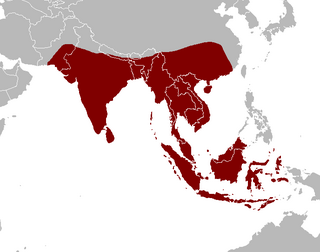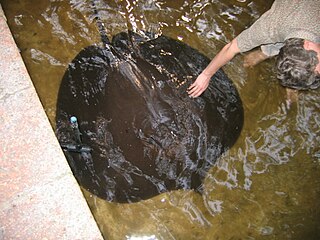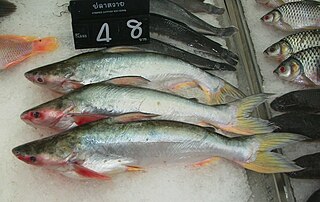
The Chao Phraya is the major river in Thailand, with its low alluvial plain forming the centre of the country. It flows through Bangkok and then into the Gulf of Thailand.

The iridescent shark,iridescent shark catfish is a species of shark catfish native to the rivers of Southeast Asia. Despite its name, it is not a shark. It is found in the Mekong basin as well as the Chao Phraya River, and is heavily cultivated for food there.

The Mekong giant catfish, is a large, threatened species of catfish in the shark catfish family (Pangasiidae), native to the Mekong basin in Southeast Asia and adjacent China. It is considered critically endangered due to overfishing and habitat loss.

Basa is a species of catfish in the family Pangasiidae. Basa are native to the Mekong and Chao Phraya basins in Mainland Southeast Asia. These fish are important as a food source, and also on the international market. They are often labelled in North America and Australia as "basa fish", "swai", or "bocourti". In the UK all species of Pangasius may legally be described as "river cobbler", "cobbler", "basa", "pangasius", "panga", or any of these with the addition of "catfish". In the rest of Europe, these fish are commonly marketed as "pangasius" or "panga". In Asian markets, names for basa include "Pacific dory" and "patin". Other related shark catfish may occasionally be incorrectly labeled as basa fish, including P. hypophthalmus and P. pangasius.

The shark catfishes form the family Pangasiidae. They are found in fresh and brackish waters across southern Asia, from Pakistan to Borneo. Among the 30-odd members of this family is the plant-eating, endangered Mekong giant catfish Pangasianodon gigas, one of the largest known freshwater fish. Several species are the basis of productive aquaculture industries in Vietnam's Mekong Delta.

Pangasianodon is a genus of large to very large shark catfishes native to the Mekong and Chao Phraya Rivers in Southeast Asia and adjacent China.

A fish is an aquatic, gill-bearing animal with a hard skull that lacks limbs with digits. This includes hagfish, lampreys, and both cartilaginous and bony fishes. Some 96% of living fish species are teleosts, bony fishes able to protrude their jaws. The bony fishes or Osteichthyes include the tetrapods, which evolved from lobe-finned fishes; major features such as having jaws and an adaptive immune system evolved in the Osteichthyes.

The giant freshwater stingray is a species of stingray in the family Dasyatidae. It is found in large rivers and estuaries in Southeast Asia and Borneo, though historically it may have been more widely distributed in South and Southeast Asia. The largest freshwater fish and the largest stingray in the world, this species grows up to 2.2 m (7.2 ft) across and can reach up to 300 kg (660 lb) in weight. It has a relatively thin, oval pectoral fin disc that is widest anteriorly, and a sharply pointed snout with a protruding tip. Its tail is thin and whip-like, and lacks fin folds. This species is uniformly grayish brown above and white below; the underside of the pectoral and pelvic fins bear distinctive wide, dark bands on their posterior margins.

The environmental impact of fishing includes issues such as the availability of fish, overfishing, fisheries, and fisheries management; as well as the impact of industrial fishing on other elements of the environment, such as bycatch. These issues are part of marine conservation, and are addressed in fisheries science programs. According to a 2019 FAO report, global production of fish, crustaceans, molluscs and other aquatic animals has continued to grow and reached 172.6 million tonnes in 2017, with an increase of 4.1 percent compared with 2016. There is a growing gap between the supply of fish and demand, due in part to world population growth.

The Jullien's golden carp is a species of endangered freshwater ray-finned fish in the family Cyprinidae found in Southeast Asian river basins. Its existence is being threatened by various economic activities, such as large-scale agriculture and the building of dams for hydropower.

The giant guitarfish, also known as the whitespotted wedgefish, is a large species of guitarfish in the family Rhinidae. It is restricted to the Red Sea, Persian Gulf, and western Indian Ocean, but was formerly considered more widespread due to confusion with its relatives.

Pangasius is a genus of medium-large to very large shark catfishes native to fresh water in South and Southeast Asia. The term "pangasius" is sometimes used to specifically refer to the commercially important basa fish, P. bocourti.

Pangasius pangasius, the Pangas catfish, is a species of shark catfish native to fresh and brackish waters of Bangladesh, India, Myanmar, and Pakistan. It has also been introduced to Cambodia and Vietnam. This species grows to a standard length of 3 metres (9.8 ft). This species South Asia, the other being P. silasi from the Krishna River.

The broadhead catfish is an economically important air-breathing catfish that is a native of Southeast Asia. The fish is farmed in ponds for use in human consumption in countries such as Thailand and the Philippines. However, native populations now face extinction due to man-made activities and genetic introgression due to interbreeding with escaped aquaculture hybrids.

The fishing industry in the land-locked country of Laos is a major source of sustenance and food security to its people dwelling near rivers, reservoirs and ponds. Apart from wild capture fisheries, which is a major component of fish production, aquaculture and stocking are significant developments in the country. Historically, fishing activity was recorded in writings on the gate and walls of the Wat Xieng Thong in Luang Prabang dated 1560. For many Laotians, freshwater fish are the principal source of protein. The percentage of people involved in regular fishing activity is very small, only near major rivers or reservoirs, as for most of the fishers it is a part-time activity.
The following outline is provided as an overview of and topical guide to fish:

Wallagonia leerii, also known as the Great Tapah, helicopter catfish, and formerly the striped wallago catfish is a species of catfish native to Southeast Asia. Its habitat ranges from the river drainages of Thailand through the Malayan peninsula to the islands of Sumatra and Borneo in Indonesia. It can grow up to 2 m in length and weigh up to 150 kg (330 lb). It has been used as food in Southeast Asia since ancient times. Overfishing for its prized meat has caused the population to significantly decrease. Furthermore, the breeding migration pattern of this fish is especially vulnerable to damming, which has also decreased the wild population significantly.
Pangasius conchophilus is a species of shark catfish. It is a freshwater, benthopelagic, potamodromous and tropical fish, measuring up to 120 centimetres (3.9 ft) long. It is found in the Mekong, Bangpakong, and Chao Phraya basins.
Pangasius myanmar is a species of shark catfish. It is a freshwater, benthopelagic, tropical fish, measuring up to 120 centimetres (3.9 ft) long. It is found from Irrawaddy to Salween and in Rangoon.



















